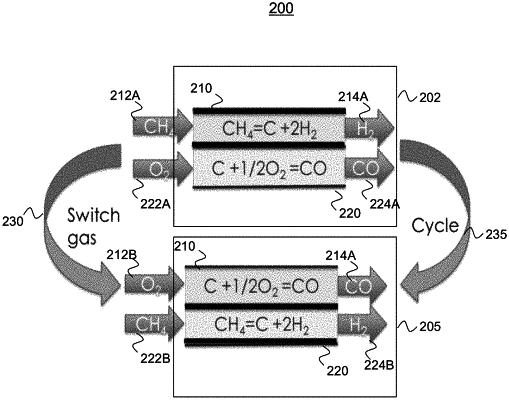| CPC C01B 3/24 (2013.01) [B01J 19/248 (2013.01); B01J 19/2445 (2013.01); C01B 32/40 (2017.08); C01B 32/50 (2017.08); B01J 2219/00051 (2013.01); B01J 2219/00164 (2013.01); B01J 2219/0218 (2013.01); C01B 2203/0255 (2013.01); C01B 2203/0272 (2013.01); C01B 2203/1235 (2013.01); C01B 2203/148 (2013.01)] | 12 Claims |

|
1. A method of generating hydrogen gas by recycling energy, comprising:
passing a material including one or more hydrocarbon structures through a first conduit that is heated above a desired threshold temperature to cause decomposition of the material into a first mixture that includes a first hydrogen gas and first carbon deposited onto a wall of the conduit;
extracting the first hydrogen gas from the first conduit as part of a hydrogen gas output;
after stopping the passing the material through the first conduit, causing oxidation of the first carbon deposited on the wall of the first conduit to convert the first carbon into a first carbon oxide gas while generating heat;
coupling the heat generated from the first conduit to a second conduit separate from the first conduit;
after stopping the passing the material through the first conduit, passing the material including one or more hydrocarbon structures through the second conduit that is heated above the desired threshold temperature by receiving the heat generated from the first conduit to cause decomposition of the material into a second mixture that includes a second hydrogen gas and second carbon deposited onto a wall of the second conduit;
extracting the second hydrogen gas from the second conduit as part of the hydrogen gas output;
after stopping the passing the material through the second conduit, causing oxidation of the carbon deposited on the wall of the second conduit to convert the second carbon into a second carbon oxide gas while generating heat; and
repeating foregoing operations to recycle energy between the first and second conduits to alternatively extract the first hydrogen gas from the first conduit and the second hydrogen gas from the second conduit sequentially in time to produce the hydrogen gas output.
|